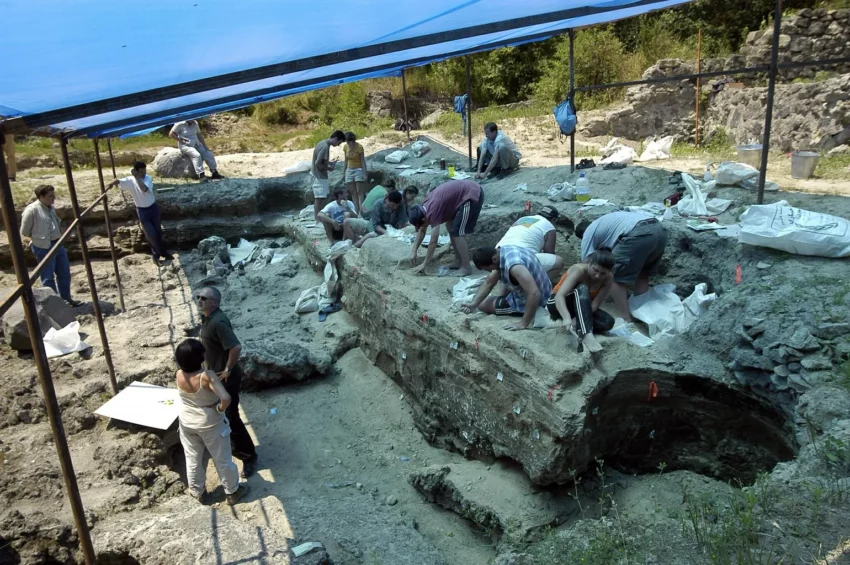Dmanisi is a significant archaeological site located in the Kvemo Kartli region of Georgia. This site gained international attention for its remarkable paleoanthropological findings. The discoveries at Dmanisi include some of the oldest hominin remains outside Africa, offering crucial insights into human evolution and migration patterns. The site provides evidence of early human life dating back to approximately 1.8 million years ago. The findings at Dmanisi have reshaped our understanding of the spread of early humans across the globe.
Get your dose of History via Email
Historical Background of Dmanisi
The discovery of Dmanisi dates back to 1983 when archaeologists unearthed ancient stone tools. Subsequent excavations led to the finding of hominin remains in 1991. Georgian scientist David Lordkipanidze played a pivotal role in the research. The site was once a medieval town, and it sits atop a promontory overlooking the confluence of two rivers. The area was a strategic point, serving as a crossroads for trade and culture.
Researchers believe that the hominins who lived in Dmanisi were part of the Homo erectus species. This group is thought to have been the first of our ancestors to leave Africa. The Dmanisi hominins likely lived in a hunter-gatherer society. They used the stone tools found at the site for various purposes, including processing food and making other tools.
The site’s location was not only a hub for ancient human activity but also witnessed significant historical events. Over the centuries, various empires and cultures influenced Dmanisi. This includes the Persians, Arabs, and Mongols, each leaving their mark on the region’s history.
Archaeological work at Dmanisi continues to this day, with each season bringing new discoveries. The site has become a focal point for understanding human prehistory. It provides a rare glimpse into the lives of some of the earliest known populations of Eurasia.
Importantly, Dmanisi has challenged the traditional view that early hominins were not capable of surviving in the diverse and variable climates of Eurasia. The evidence suggests that these early humans were more adaptable and resourceful than previously thought. This has significant implications for our understanding of human evolution.
About Dmanisi
Dmanisi is renowned for its well-preserved archaeological remains. The site includes remnants of buildings, ancient streets, and a complex of medieval fortifications. The hominin fossils found here are among the most significant discoveries. They provide a direct link to our earliest ancestors.
The hominin remains discovered at Dmanisi are notable for their diversity. They exhibit a range of features that suggest a high degree of variation within the early Homo erectus population. This has led to debates about species classification and the nature of human evolution.
The stone tools found at Dmanisi are relatively simple. They are characteristic of the Oldowan technology, which is named after the Olduvai Gorge in Tanzania where similar tools were first found. These tools represent some of the earliest evidence of tool use by hominins.
The site’s layout and the artifacts found suggest that Dmanisi was a settlement with social and economic structures. The inhabitants likely relied on the surrounding environment for sustenance. They may have hunted local wildlife and gathered plant foods.
Conservation efforts at Dmanisi are ongoing. The site is open to the public, and it includes a museum that displays many of the artifacts and fossils found during excavations. Dmanisi continues to be an important site for both research and education.
Theories and Interpretations
The discoveries at Dmanisi have sparked numerous theories about early human migration and evolution. One theory suggests that the hominins at Dmanisi represent a single species with a wide range of physical traits. This challenges the notion that distinct species such as Homo habilis and Homo erectus lived at the same time.
Another theory posits that the Dmanisi hominins were part of an early migration out of Africa. This migration may have occurred much earlier than previously thought. The Dmanisi findings suggest that early humans were capable of adapting to new environments quickly.
Some researchers have proposed that the Dmanisi hominins used social cooperation and communication to survive. This would have been necessary in the challenging and variable climate of the region. The use of tools and the evidence of animal butchery support this theory.
Interpretations of the site have also been informed by the geological context. The dating of the hominin remains and artifacts has been carried out using methods such as paleomagnetism and radiometric analysis. These methods have confirmed the age of the site at around 1.8 million years.
The Dmanisi discoveries continue to be a subject of intense study and debate. Each new finding has the potential to alter our understanding of human history. The site remains a treasure trove for scientists seeking to unravel the mysteries of our past.
At a glance
- Country: Georgia
- Civilization: Homo erectus
- Age: Approximately 1.8 million years (Pleistocene epoch)

